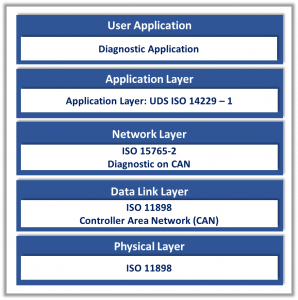ISO 14229 UDS Protocol Stack: The Future of Automotive Diagnostics
The automotive industry is drastically evolving, with the main reasons behind this evolution being the increased need for safety and improved driving experience. Cars on the road today contain as many as 40 to 150 individual ECUs, each performing specific functions such as electronic fuel injection (EFI), engine control, door locks, braking, window operation, and more.
Increased complexity requires more efficient ways to test and diagnose vehicle systems when a fault occurs. There have been many diagnostic protocols like KWP 2000, ISO 15765, and K-Line developed over time for vehicle diagnostics. So, to ensure universal compatibility, OEMs and Suppliers agreed to rely on a standard protocol which is named as Unified Diagnostic Services Protocol.
Unified Diagnostic Services (UDS) is the latest automotive vehicle diagnostic protocol used to diagnose vehicles worldwide. This protocol is defined in the ISO-14229 standard and automobile OEMs follow this standard to provide a common computer system that can be used to diagnose any vehicle.
Architecture of UDS Protocol
Nowadays, the utilization of the protocol is increasing due to its flexibility. This protocol is derived from the ISO 14230-3 (KWP-2000) and ISO 15765-3 (Diagnostic Communication over the CAN (DoCAN). It is used for vehicle diagnostic, ECU firmware flashing, and many more such functions.
The UDS protocol uses fifth (Session layer) and seventh (Application layer) layer of the OSI model while the CAN protocol works on the first (Physical layer – ISO 11898-2) and second (Data Link layer – ISO 11898-2) layer of the OSI model.
Why Diagnostics is needed in a vehicle?
The protocol is defined for two types of devices, namely, Server and Client. The vehicle will be the Server and the diagnostic device will be the Client. Recent vehicles are equipped with a diagnostic interface, which makes it possible to connect a computer or diagnostics tool, to the communication system of the vehicle (ECU). UDS requests are sent to the controllers which provide a positive or negative response. With these responses provided from the controller, it is possible to diagnose faults and undesirable behavior inside vehicles such as:
- Data stored within the system
- Memory available in the individual control units
- Live vehicle data such as engine or vehicle speed
- Firmware updates
- Interaction with hardware I/O to turn the specific output ON or OFF based on the response to identify the fault
- Run specific functions to understand the environment and operating conditions of an ECU
Diagnostic Services offered by the iWave ISO 14229 UDS Protocol Stack:
The UDS protocol offers 6 different Client services for the categories of tasks to be performed on the server such as:
- Diagnostic and communication management
- Data Transmission
- Stored Data Transmission
- Input/Output Control
- Remote activation of routine
- Upload/Download
iWave has designed the UDS protocol stack to be fully customizable, allowing users to specify feature sets and fine-tune the stack to meet the end application requirements of the Client device.
Value proposition of UDS protocol stack:
- Easy to Use APIs
- End to End solution offerings for Telematics Solutions
- Supported in all available kernel versions
- Development of APIs for integration with customer-specific hardware platform and application
To get in touch with us for enquiries and further information, please write to mktg@iwavesystems.com or contact our Regional Partners.



